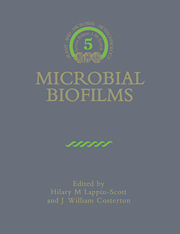Book contents
- Frontmatter
- Contents
- List of Contributors
- Series Preface
- Introduction to Microbial Biofilms
- Part I Structure, Physiology and Ecology of Biofilms
- Part II Biofilms and Inert Surfaces
- Part III Biofilms on the Surfaces of Living Cells
- 12 The Rhizosphere as a Biofilm
- 13 Biofilms of the Ruminant Digestive Tract
- 14 The Immune Response to Bacterial Biofilms
- 15 Bacterial Biofilms in the Biliary System
- 16 Biofilm Associated Urinary Tract Infections
- 17 The Role of the Urogenital Flora in Probiotics
- 18 Dental Plaque
- Index
17 - The Role of the Urogenital Flora in Probiotics
Published online by Cambridge University Press: 24 November 2009
- Frontmatter
- Contents
- List of Contributors
- Series Preface
- Introduction to Microbial Biofilms
- Part I Structure, Physiology and Ecology of Biofilms
- Part II Biofilms and Inert Surfaces
- Part III Biofilms on the Surfaces of Living Cells
- 12 The Rhizosphere as a Biofilm
- 13 Biofilms of the Ruminant Digestive Tract
- 14 The Immune Response to Bacterial Biofilms
- 15 Bacterial Biofilms in the Biliary System
- 16 Biofilm Associated Urinary Tract Infections
- 17 The Role of the Urogenital Flora in Probiotics
- 18 Dental Plaque
- Index
Summary
Introduction
In order to examine whether or not the flora of the healthy adult female urogenital tract has any role in protecting a host from infection, and thereby performing a probiotic function, we must first outline the formation, composition and fluctuations of the flora. This is not a simple task as factors such as age and hormonal status influence the type and quantity of organisms present. In simple terms, the establishment of the flora can be seen to follow the path outlined in Fig. 17.1. This figure is based upon epidemiological studies of the urogenital flora (Reid et al. 1990b, c; Sadhu et al. 1989) and a theory for maintenance and causation of infection.
The primary colonizers comprise organisms such as lactobacilli, Gram positive cocci and diphtheroids which have dominated the flora from puberty. In general, the secondary colonizers can comprise a number of species, including potential pathogenic coliforms, Escherichia coli, coagulase negative staphylococci, Klebsiella, Proteus sp. and other Gram positive and Gram negative bacteria. Depending upon the virulence of these secondary colonizers, the host may be able to maintain an infection free state or succumb to the pathogens which then infect the bladder or vagina.
Morphological and structural analyses of the urogenital flora adherent to the epithelia have shown the presence of many distinct organisms, often interacting and coaggregating, in micro colonies or diffuse patterns on the cells (Sadhu et al. 1989; Reid et al. 1990c). Figure 17.2 illustrates this adherence, primarily dominated by Lactobacillus species. The presence of glycocalyx material intertwined between the cells is evident.
In vitro studies have to some extent mimicked this coaggregation or cooperativity between lactobacilli and other urogenital organisms, including potential pathogens.
- Type
- Chapter
- Information
- Microbial Biofilms , pp. 274 - 281Publisher: Cambridge University PressPrint publication year: 1995
- 2
- Cited by

